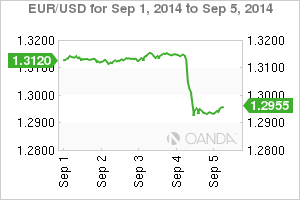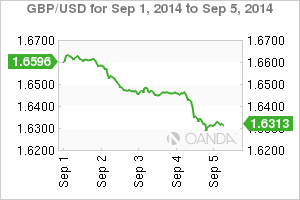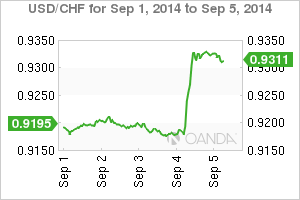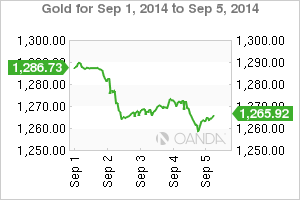The European Central Bank (ECB) came, delivered, and made a difference this week. Investors and dealers were positioned for further disappointment from eurozone policymakers, but what “Super Mario” (read: ECB chief Mario Draghi) did has had a far greater impact on the market.
The ECB made a bold move to avert eurozone deflation and growth fears by slashing rates and setting the market up for a bond-buying program beginning next month. Interestingly, a few months ago the asset-backed securities (ABS) market did not have the significant structure or depth for the ECB, but now it is ready to be introduced in October. In addition, the ECB has kept open the possibility of taking further steps should inflation stay low and fail to move higher. This was a very different ECB, more aggressive than what the market is normally used to, especially after its June message that interest rates were at their lower bound. It’s safe to say few had expected the ECB to act as aggressively so soon.
Cut, Cut, and Introduce
Draghi and company cut the ECB’s refinancing rate to +0.05% from +0.15% and its deposit rate to -0.2% from -0.1%. Again they pronounced that the ECB was now officially at the lower bound of interest rates and that no more rate cuts were possible. Few details of the new program were disclosed beyond it would include new and existing ABS, covered bonds, and mortgage-backed securities. Obviously, the market will have to wait to gauge the success of the TLTROs (targeted longer-term refinancing operation) and ABS/covered bonds programs. Until then the immediate impact is coming from the ECB’s negative interest rate policy. European money market rates out to three-year Euro OverNight Index Average, and the Bund curve, out to 2018, are all trading with a negative yield. From an investment perspective, investors will be forced to take on more risk as they search for a positive return.
Unanimity Rules
This week’s ECB decisions were not unanimous, only a “comfortable majority” was in favor of the moves. Market reaction to the news saw European equity indices rally and are looking to end the week close to their highs, while sovereign yield curves have notably steepened. The EUR has since plummeted with the 18-member single currency trading at a 14-month low (€1.2935). The ECB’s surprise rate cut will force other central banks to act. The knock-on effect will pressure the Swiss National Bank (SNB) to react (the threat of intervention) if EUR/CHF happens to penetrate its designated ‘floor’ established three years ago (€1.2000). The SNB’s next meeting is on September 18.
What to Expect Next Week
After the rollicking market action that ensued following Draghi’s performance, next week might seem like a bit of a letdown. Regardless, China kicks things off with its trade balance on Monday, its inflation numbers on Wednesday, and will close out the week with industrial production numbers on Saturday. Down Under, the Aussies will release business confidence numbers and give us more color on their job market. The Reserve Bank of New Zealand is not expected to do anything to its overnight rates (+3.5%) on Wednesday. Stateside, the U.S. will give us core-retail sales on Friday and will close out the week with the University of Michigan’s consumer sentiment survey.
This article is for general information purposes only. It is not investment advice or a solution to buy or sell securities.
Opinions are the authors — not necessarily OANDA’s, its officers or directors. OANDA’s Terms of Use and Privacy Policy apply. Leveraged trading is high risk and not suitable for all. You could lose all of your deposited funds.
Recommended Content
Editors’ Picks
EUR/USD edges lower toward 1.0700 post-US PCE

EUR/USD stays under modest bearish pressure but manages to hold above 1.0700 in the American session on Friday. The US Dollar (USD) gathers strength against its rivals after the stronger-than-forecast PCE inflation data, not allowing the pair to gain traction.
GBP/USD retreats to 1.2500 on renewed USD strength

GBP/USD lost its traction and turned negative on the day near 1.2500. Following the stronger-than-expected PCE inflation readings from the US, the USD stays resilient and makes it difficult for the pair to gather recovery momentum.
Gold struggles to hold above $2,350 following US inflation

Gold turned south and declined toward $2,340, erasing a large portion of its daily gains, as the USD benefited from PCE inflation data. The benchmark 10-year US yield, however, stays in negative territory and helps XAU/USD limit its losses.
Bitcoin Weekly Forecast: BTC’s next breakout could propel it to $80,000 Premium

Bitcoin’s recent price consolidation could be nearing its end as technical indicators and on-chain metrics suggest a potential upward breakout. However, this move would not be straightforward and could punish impatient investors.
Week ahead – Hawkish risk as Fed and NFP on tap, Eurozone data eyed too

Fed meets on Wednesday as US inflation stays elevated. Will Friday’s jobs report bring relief or more angst for the markets? Eurozone flash GDP and CPI numbers in focus for the Euro.



